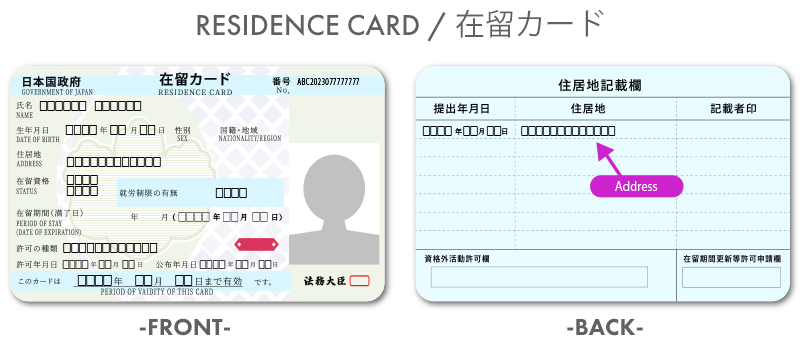Moving to Japan: The 4 Essential Things to Know Before Renting an Apartment

To successfully rent your first apartment in Japan without unnecessary complications, follow these four essential steps: First, register your hotel or Airbnb address on your residence card—this step is crucial for setting up your phone number. Next, obtain a personal hanko (seal), which is necessary for signing your rental contract. Finally, opening a Japanese bank account will ensure you’re prepared to pay your monthly rent seamlessly. By completing these steps in advance, you’ll make your apartment search and rental process much smoother.
1. Register Your Address on the Zairyu Card (Residence Card)
One of the first things you must do upon arriving in Japan is registering your address on the back of your Zairyu card (residence card). This is a legal requirement, enforced by the Japanese government. You have 14 days after landing to complete this process. Without a registered address, you won’t be able to rent a property in Japan.

If you don’t have a permanent address yet, you can register a temporary address, such as a hotel or Airbnb. To do this, simply visit your local city hall, where the staff will help you with the necessary forms. Once registered, your address will appear on your Zairyu card, and you’ll be able to proceed with your apartment search.
If you are located in Tokyo, you can find your local city hall office in this list.
| Ward | City Hall Google Maps Link |
|---|---|
| Adachi-ku | Adachi City Hall |
| Chiyoda-ku | Chiyoda City Hall |
| Itabashi-ku | Itabashi City Hall |
| Koto-ku | Koto City Hall |
| Nakano-ku | Nakano City Hall |
| Setagaya-ku | Setagaya City Hall |
| Shinjuku-ku | Shinjuku City Hall |
| Taito-ku | Taito City Hall |
| Arakawa-ku | Arakawa City Hall |
| Chuo-ku | Chuo City Hall |
| Katsushika-ku | Katsushika City Hall |
| Meguro-ku | Meguro City Hall |
| Nerima-ku | Nerima City Hall |
| Shibuya-ku | Shibuya City Hall |
| Suginami-ku | Suginami City Hall |
| Toshima-ku | Toshima City Hall |
| Bunkyo-ku | Bunkyo City Hall |
| Edogawa-ku | Edogawa City Hall |
| Kita-ku | Kita City Hall |
| Minato-ku | Minato City Hall |
| Ota-ku | Ota City Hall |
| Shinagawa-ku | Shinagawa City Hall |
| Sumida-ku | Sumida City Hall |
2. Get a Japanese Phone Number
Before applying for an apartment, you’ll need a local Japanese phone number. It may seem trivial, but having a Japanese phone number is essential because property management and insurance companies will need to contact you directly.
Make sure to register your address first, as many phone providers require it. One popular option is Rakuten Mobile, known for its quality and cost-effective plans, making it one of the best choices in 2024. The subscription process is also available in English which make the process very easy.
However, for anyone who wants to apply directly in a store, here is a non-exhaustive list of places where you can find Rakuten in Shibuya.
| Store Name | Google Maps Link |
|---|---|
| Rakuten Mobile Shibuya Store | Rakuten Mobile Shibuya Store |
| Bic Camera Shibuya East Exit (Rakuten Mobile Counter) | Bic Camera Shibuya East Exit |
| Rakuten Mobile Yodobashi Shibuya Counter | Yodobashi Camera Multimedia Shibuya |
3. Obtain a Hanko (Personal Seal)
In Japan, signatures are still often made using a hanko (personal seal). This is required to sign contracts, including rental contracts and is also needed for tasks like opening a bank account.
You can buy a basic hanko at many different shops, ranging from specialized local hanko shops to 100-yen stores like Daiso. The most common and convenient option is Don Quijote.
Be aware that only a few Daiso and Don Quijote stores sell hanko.
However, it’s important to register your hanko at your local city office to obtain a Hanko Shomeisho (certificate of registration). This ensures that your hanko can be officially recognized.
You can learn more about getting and registering a hanko in our dedicated article here.
Meanwhile, for everyone in Tokyo, here is a non-exhaustive list of places where you can buy a Hanko in Shibuya.
| Shop Name | Google Maps Link |
|---|---|
| Shibuya Hanko Center | Shibuya Hanko Center |
| Tokyu Hands Shibuya (Stationery Section) | Tokyu Hands Shibuya |
| Don Quijote Shibuya | Don Quijote Shibuya |
| 100 Yen Shop Daiso (Shibuya Mark City) | Daiso Shibuya Mark City |
| Loft Shibuya (Personalized Hanko Section) | Loft Shibuya |
| Online Option: Hanko Japan | Hanko Japan Website |
4. Open a Japanese Bank Account
Most landlords require rent payments to be made via bank-to-bank transfers, so opening a Japanese bank account is another important step. It usually takes three to five days to set up an account, but some banks, like Japan Post Bank, offer faster processing or allow you to apply online in English.
You’ll need the following to open an account:
- Your Zairyu card with a registered address
- Proof of employment or enrollment in a school
- Your hanko (personal seal)
- Someone to help interpret, if necessary
Note: Most bank accounts will come with a debit card, and fees may apply when using ATMs outside of bank hours or at third-party machines (typically ranging from 110 to 310 yen).
Here is the list of post bank branches in Tokyo, where you can open an account in less than an hour.
| Ward | Yūchō Office Google Maps Link |
|---|---|
| Adachi-ku | Adachi Yūchō Office |
| Chiyoda-ku | Chiyoda Yūchō Office |
| Itabashi-ku | Itabashi Yūchō Office |
| Koto-ku | Koto Yūchō Office |
| Nakano-ku | Nakano Yūchō Office |
| Setagaya-ku | Setagaya Yūchō Office |
| Shinjuku-ku | Shinjuku Yūchō Office |
| Taito-ku | Taito Yūchō Office |
| Arakawa-ku | Arakawa Yūchō Office |
| Chuo-ku | Chuo Yūchō Office |
| Katsushika-ku | Katsushika Yūchō Office |
| Meguro-ku | Meguro Yūchō Office |
| Nerima-ku | Nerima Yūchō Office |
| Shibuya-ku | Shibuya Yūchō Office |
| Suginami-ku | Suginami Yūchō Office |
| Toshima-ku | Toshima Yūchō Office |
| Bunkyo-ku | Bunkyo Yūchō Office |
| Edogawa-ku | Edogawa Yūchō Office |
| Kita-ku | Kita Yūchō Office |
| Minato-ku | Minato Yūchō Office |
| Ota-ku | Ota Yūchō Office |
| Shinagawa-ku | Shinagawa Yūchō Office |
| Sumida-ku | Sumida Yūchō Office |
Conclusion
Moving to Japan can be an exciting yet complex process, but by following the essential steps outlined here—registering your address, getting a phone number, obtaining a hanko, and opening a bank account—you'll be well-prepared to rent an apartment and start your new life in Japan.
Make sure to complete each of these steps in order to ensure a smooth transition into your new home. Once you've got everything in place, you'll be ready to settle down and enjoy your experience in Japan!
